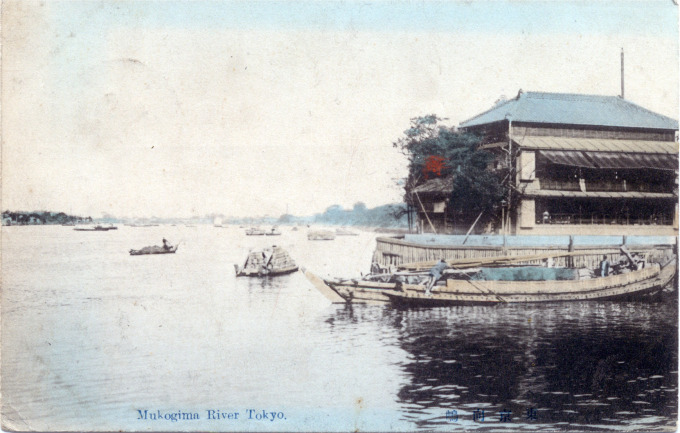
Yaomatsu restaurant (right), across from Asakusa, at the Makurabashi ferry crossing, c. 1910. The large, broad roof of Asakusa Sensoji (Asakusa Kannon) can be seen in the distance.
“We are on our way to the far end of the long Mukojima highway, at least six miles from town, where we shall find an inn that is completely and entirely Japanese in structure and surroundings. It is called the ‘Yao Matsu,’ ‘The Place of Eight-Hundred Pine-Trees.’
“It is the most aristocratic resort of Tokyo, patronized only by the richer Japanese, unknown to foreigners, unmentioned in ‘Murray’s,’ remote from tramways, far above the terminus of the puffy tugboats on the river – in a word, secure from all the influences which are dispelling the peaceful atmosphere and ruining the picturesqueness of Japan.”
– Burton Holmes Travelogues, by Burton Holmes, 1901
“First came the earthquake recovery projects of Hamacho and Sumida parks, both featuring modern promenades along the Sumida riverfront. They and Kinshi Park – the three major parks incorporated into the city’s earthquake recovery plan – were meant to promote the health, sanitation, rest, and recreation that Tokyo residents required.
“Sumida Park made its debut as a mile-long promenade along both sides of the river, with an innovative Western design that restored the lyrical Sumida landscape. In order to create just the right modern vista, the venerable Yaomatsu restaurant was torn down.”
– Tokyo, a Spatial Anthropology, by Hidenobu Jinnai, 1995




Pingback: Sumida River Ferry Boats, c. 1910. | Old Tokyo
Pingback: Cherry Blossoms at Mukojima, c. 1910. | Old TokyoOld Tokyo